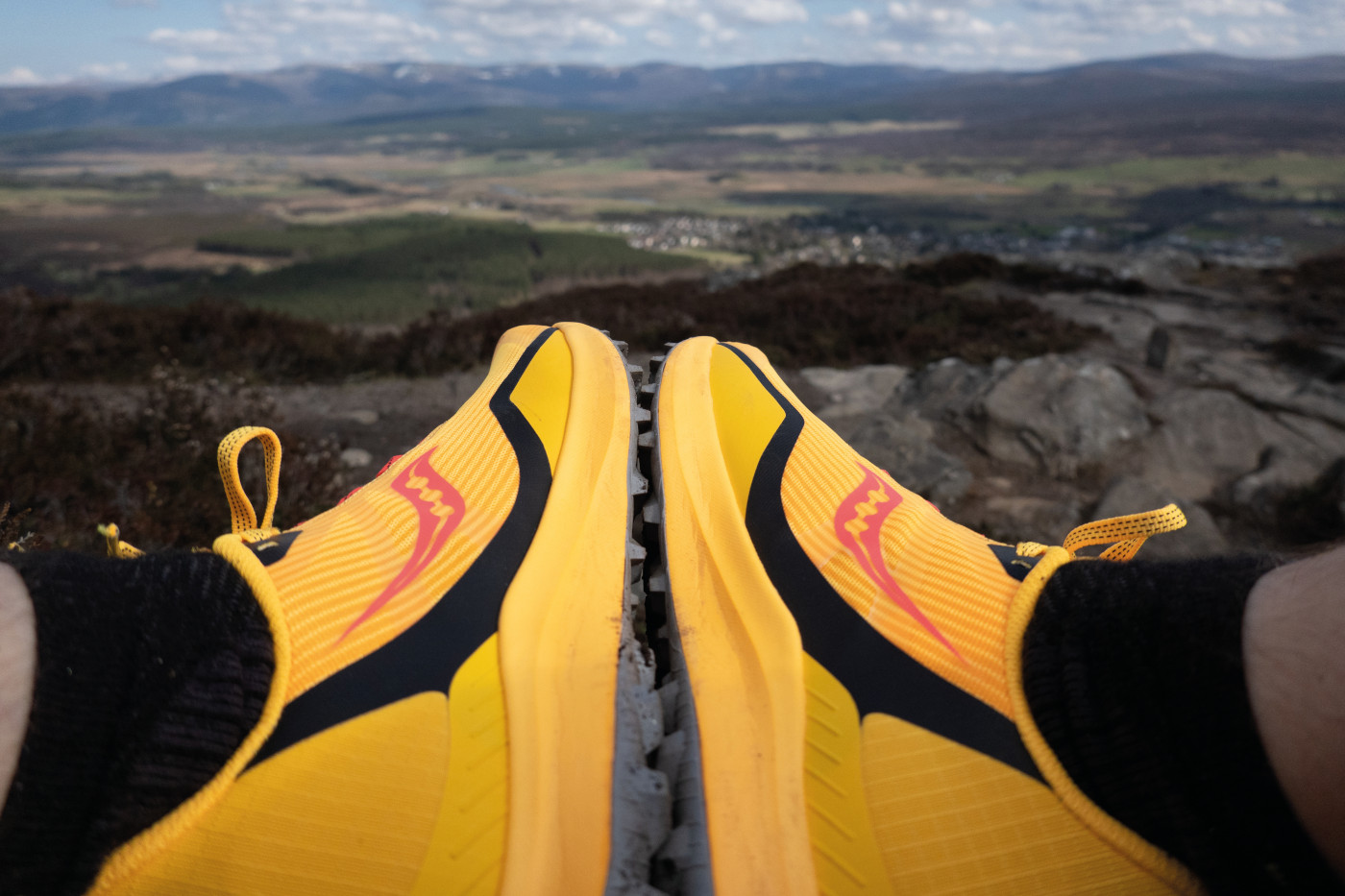



In this comparative roundup, we’re looking at the best trail shoes or ‘trail runners’. These are not the fabric, three season walking shoes or low-cut boots we might use for hillwalking if we want to keep our feet dry, but lightweight ‘trainers’ with an outdoor focus. They’re the choice for mountain and fell runners, and are increasingly favoured by hillwalkers, too.
What is the difference between trail shoes and hiking shoes?
Words: David Lintern & Fiona Russell | Main image: David Lintern
The Great Outdoors has long promoted the use of lighter-weight footwear in the warmer months, primarily via the reviews and trip reports of Chris Townsend… and many of us have followed in his footsteps. Up until a decade or so ago, I (David) assumed that ‘proper hillwalkers’ had to wear old-fashioned leather boots all year round: that was the uniform. But I tried on lighter boots and then trail shoes, and felt far less tired at the end of the day. My ankles and toes were allowed to flex (just like they were designed to!); and without a so-called waterproof membrane, my feet could breathe and were liberated from sweating and blisters. Apparently, I was not a ‘proper hillwalker’, but that was OK!
In 2011, I hiked for two months across the Pyrenees. At that point, I wasn’t quite brave enough to take the plunge completely, and I began the walk in a pair of traditional three season, lined boots. Early on, conditions alternated between very hot and very wet, and I got a nasty case of trench foot. My feet were in such poor shape by week four I thought I would have to stop. Only the liberal application of iodine (quite an old-fashioned remedy; not sure I’d it recommend now!) dried the skin out and saved the hike. I replaced those manky boots with a pair of very lightweight, no-membrane trail runners – and had zero issues thereafter.
The more I used trail shoes, the more I understood the benefits. Less weight meant I felt nimbler and less clumsy. I paid more attention to where I put my feet and began to engage more with the terrain. My joints became stronger, my footwork more precise. I rarely get blisters now.
There are tradeoffs, of course. Trail shoes without a ‘waterproof’ membrane mean feet get wet. Conversely, they dry out more quickly when it stops raining. Carrying very heavy loads or moving in very rough terrain can warrant a larger drop in the heel or more protection in the toe than some trail shoes offer – although there are now options to cater for the ultramarathon and skyrace scenes that go a long way to mitigate those concerns, some of which we look at here. And, of course, trail shoes are not built for winter; so we shouldn’t expect them to play well with crampons and axes. But by and large, between April and October, I’m far more fleet of foot in ‘hill pumps’.
Outsole
Soles should offer a level of grip to suit your chosen terrain, and you’ll see deeper and more densely packed lugs on shoes that aim to offer more grip on wet, muddy and steep ground.
Stiffness
Traditional trail walking shoes are usually designed with a stiffer sole because the motion of walking, compared to running, requires less flexibility. If you want to use your trail shoes for walking and running, it’s a good idea to ensure they are flexible enough to complement your natural running gait. There is a compromise to be found here, though, because a shoe that is too flexible will not necessarily be as comfortable when walking long-distance when more support is usually required.
Rock plate
Some shoes have a rock plate, which is a material embedded between the outsole and the midsole for underfoot protection. It can add stability and stiffness to the shoe and helps to protect the soles of your feet from sharp rocks and stones.
Midsole
The level of cushioning is a personal choice, but you should think about where you will be walking and running. A shallower sole usually means there is less cushioning and better ‘ground feel’, whilst deeper soles are likely to offer greater levels of cushioning. On rough terrain, a deeper sole may result in instability for some.
Heel-to-toe drop
Regardless of the depth of sole, shoes offer a range of heel-to-toe drop and that is the difference in height – usually in mm – of the stacked heel to the forefoot. Road running shoes will normally have a larger drop, often with the aim of protecting the Achilles tendon from being overly stretched, whilst trail running shoes usually have a much shallower drop.
Uppers
Trail shoes need to be durable and offer protection against abrasion caused by vegetation, rocks, stones, scree and mud. Expect to see a protective rand around the base of the upper where it meets the sole, as well as toe bumpers or caps and heel protectors. There should still be a good degree of upper flexibility so foot flex and breathability aren’t inhibited.
Waterproofing
A built-in waterproof liner, such as Gore-Tex, will offer some waterproofing if you are walking or running in the rain, on wet ground or when crossing streams and rivers. Waterproof liners can make the shoe less breathable, so you end up with sweatier feet in warm conditions. To stop the wet getting in at the ankle area, you can wear lightweight running gaiters.
Lacing
Whether traditional lacing or another system, the aim should be for an even tension along the length of the foot.
Weight
Weight should be considered against sturdiness. Generally, very lightweight shoes will not be as long-lasting or durable as a heavier shoe; although this also does depend on the materials and construction quality.
Recycled materials
More now than ever, brands are keen to inform consumers about recycled content in their products. This is good news, but it’s important to consider the potential for ‘greenwashing’ and also more than just the materials. How and where the products are made, end-of-life recycling schemes, sustainability certifications and pledges are all worth considering.
Women’s trail shoes
Fiona is a size UK8.5 and has a narrow foot. She is a keen trail and hill runner, as well as a hillwalker. To test the trail shoes, she walked and ran in each pair on the full range of terrain, from forest tracks to off-path mountain slopes, through peat hags, bog and streams and on ground covered in tussocks, heather, rocks, stones and grass. The product weights are per pair and are taken from Fiona’s digital scales.
Men’s trail shoes
David is a size UK10.5 and has a wide forefoot and a narrow heel. He’s an occasional trail and hill runner, and an advocate for trail shoes for walking and backpacking during the summer months. These trail shoes were tested last spring, summer and autumn on- and off-trail in the mountains throughout Scotland, from the north-west to the Borders – walking, backpacking and on the odd hill run.

